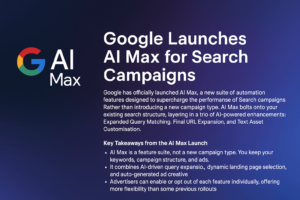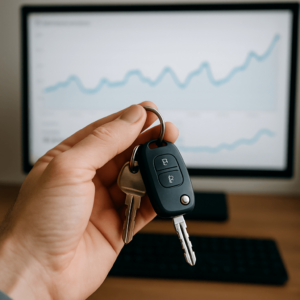Google Unveils AI Max for Search Campaigns Amid Mixed Reactions

Google has officially launched AI Max, a new suite of automation features designed to supercharge the performance of Search campaigns. Rather than introducing a new campaign type, AI Max bolts onto your existing search structure, layering in a trio of AI-powered enhancements: Expanded Query Matching, Final URL Expansion, and Text Asset Customisation.
The promise? More conversions, smarter targeting, and less hands-on workload. The reality? It depends on how much control you’re prepared to hand over to Google’s machine—and how prepared your campaigns and website are to support that automation.
At PPC Geeks, we approach tools like this with cautious curiosity. While there’s no denying AI Max offers new opportunities to increase reach and performance, we’ve also seen first-hand how poorly configured automation can burn through budget and dilute brand messaging.
Key Takeaways from the AI Max Launch
-
AI Max is a feature suite, not a new campaign type. You keep your keywords, campaign structure, and ads.
-
It combines AI-driven query expansion, dynamic landing page selection, and auto-generated ad creative.
-
Advertisers can enable or opt out of each feature individually, offering more flexibility than some previous rollouts.
-
Performance data looks strong—Google reports an average 14% increase in conversions and up to 27% uplift for more tightly controlled accounts.
-
But many advertisers are voicing concerns around brand safety, keywordless targeting, and loss of control.
What Exactly Is AI Max?
Google describes AI Max as an evolution, not a revolution—and we agree. It brings together capabilities already seen in features like Responsive Search Ads, Dynamic Search Ads and Performance Max, but integrates them into standard Search campaigns.
Here’s what’s included:
-
Expanded Query Matching: Google’s AI analyses your landing pages, existing keywords, and ads to match your campaign with additional relevant search queries—beyond what your keyword list currently covers. This includes the use of broad match and so-called “keywordless” targeting. Advertisers with historically narrow targeting (e.g. exact match) could see major gains from this added reach.
-
Final URL Expansion: When enabled, Google can dynamically choose a more relevant landing page from your domain than the one you’ve set in your ads—based on the user’s search intent. This mirrors how Dynamic Search Ads work and is particularly useful for larger websites or product catalogues where one static URL might not always be the best fit.
-
Text Asset Customisation: Think of this as an upgraded version of Automatically Created Assets. Google generates new headlines and descriptions on the fly using your website content, ad history, and landing pages. The goal is to better match ad creative to each searcher’s query and intent.
Together, these features are designed to expand reach, increase relevance, and reduce manual labour—without requiring a ground-up rebuild of your account structure. From a practical standpoint, AI Max sits inside your current campaigns, meaning advertisers can test it with minimal disruption.
Where the Community Stands: Excited but Cautious
While Google is positioning AI Max as a major step forward, the reception from the advertising community has been mixed—and understandably so.
Advertiser Concerns Include:
-
Loss of Control: The idea of keywordless targeting and auto-generated ad copy makes many advertisers uneasy. Control over message, targeting, and user experience is critical—especially in industries where compliance and accuracy are non-negotiable.
-
Brand Safety: What happens when the AI chooses to send a user to an irrelevant or outdated page? Or writes a headline that doesn’t match your tone of voice? These are real risks, particularly for regulated sectors like healthcare, finance, and legal.
-
Naming Confusion: The name AI Max has caused some confusion among advertisers, many of whom initially mistook it for a new campaign type. In reality, it’s a bolt-on to Search campaigns—but clear internal communication will be key to avoid misalignment across teams.
At PPC Geeks, we’ve seen similar growing pains with earlier automation rollouts, such as Performance Max. While Google has introduced more opt-out controls and visibility this time around, we believe a cautious, strategic approach is still essential.
Does It Work? What the Early Data Says
Google has released several beta case studies showing strong performance from AI Max in test environments. Highlights include:
-
L’Oréal: Reported a 2X increase in conversion rate and a 31% drop in cost-per-conversion after switching on AI Max. The uplift came largely from net-new search queries—terms the brand hadn’t previously targeted.
-
MyConnect: An Australian utility provider already using broad match and Smart Bidding, saw 16% more leads at a 13% lower CPA, with 30% of conversions coming from newly captured queries.
-
Overall Data: Across Google’s trials, advertisers using AI Max saw an average uplift of 14% in conversions at a similar cost. Campaigns that had been limited to exact and phrase match keywords saw up to 27% more conversions simply by enabling AI Max’s query expansion.
These figures are impressive—but should be viewed with context. Google doesn’t publish results from advertisers who didn’t benefit, and there’s always nuance behind performance data. Still, the gains suggest that for advertisers willing to test thoughtfully, there is real upside to be had.
Strategic Advice for Advertisers
Google has made it clear: AI Max is optional. You can opt in, test it on a limited set of campaigns, and back out if the results don’t hold up. That’s a big improvement on earlier automation features, where advertisers often had less flexibility.
At PPC Geeks, we’re recommending advertisers:
-
Start small: Enable AI Max on one or two lower-risk campaigns and measure results.
-
Set up guardrails: Use the new controls for brand, location, and URL exclusions from day one.
-
Monitor performance: Keep a close eye on search term reports and auto-generated creatives.
-
Track the right metrics: Make sure AI is being fed with accurate conversion signals, especially offline sales where possible.
Final Thoughts
AI Max is not a silver bullet—but it might be a powerful performance lever when used with care. Google has done well to give advertisers more transparency and flexibility this time, but that doesn’t mean we should blindly hand over the keys.
As with any automation, success comes down to preparation, testing, and ongoing oversight. Use the tools. Set the limits. Track the results. That’s how we make sure AI Max works for you, not just for Google.
Sources
- Google Ads AI Max: Automation with a side of anxiety, Search Engine Land.
- Google Ads AI Max For Search Campaigns, Search Engine Roundtable.
- Introducing AI Max for Search campaigns, Google Blog.
- Google Launches ‘AI Max For Search’ Beta 05/06/2025, MediaPost.
- Google Launches AI Max for Search Campaigns, Search Engine Journal.
Author
Search Blog
Free PPC Audit
Subscribe to our Newsletter
The Voices of Our Success: Your Words, Our Pride
Don't just take our word for it. With over 100+ five-star reviews, we let our work-and our satisfied clients-speak for us.
"We have been working with PPC Geeks for around 6 months and have found Mark and the team to be very impressive. Having worked with a few companies in this and similar sectors, I rate PPC Geeks as the strongest I have come across. They have taken time to understand our business, our market and competitors and supported us to devise a strategy to generate business. I value the expertise Mark and his team provide and trust them to make the best recommendations for the long-term."
~ Just Go, Alasdair Anderson


